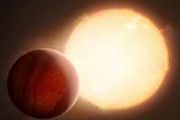
Copernical Team
Asteroid Impact Crater in Germany Offers New Perspectives on Martian Analogs
 Nestled just north of the Danube in southern Germany, the Nordlinger Ries presents a striking geological feature: a large, circular depression surrounded by hills, created by an asteroid impact nearly 15 million years ago. This site has become a critical reference point for understanding similar craters on early Mars, particularly since NASA's exploration of Martian craters began in earnest.
Nestled just north of the Danube in southern Germany, the Nordlinger Ries presents a striking geological feature: a large, circular depression surrounded by hills, created by an asteroid impact nearly 15 million years ago. This site has become a critical reference point for understanding similar craters on early Mars, particularly since NASA's exploration of Martian craters began in earnest. CisLunar Industries Joins DARPA's Innovative LunA-10 Lunar Infrastructure Program
 CisLunar Industries, an emerging name in space technology, has secured a significant contract with DARPA for the LunA-10 capability study, marking a major step in advancing lunar infrastructure development. This contract positions CisLunar Industries at the forefront of efforts to redefine lunar operations and services.
The LunA-10 program, undertaken by DARPA, is a forward-looking initiat
CisLunar Industries, an emerging name in space technology, has secured a significant contract with DARPA for the LunA-10 capability study, marking a major step in advancing lunar infrastructure development. This contract positions CisLunar Industries at the forefront of efforts to redefine lunar operations and services.
The LunA-10 program, undertaken by DARPA, is a forward-looking initiat NASA identifies probable reason for OSIRIS-REx capsule parachute deployment issue
 NASA's OSIRIS-REx sample return capsule successfully touched down under parachute in Utah's desert on September 24, 2023, delivering a container filled with rocks and dust from the near-Earth asteroid Bennu. Despite the successful delivery, the landing sequence encountered a minor hiccup. A smaller parachute, known as a drogue, did not deploy as planned.
A detailed analysis of the descent
NASA's OSIRIS-REx sample return capsule successfully touched down under parachute in Utah's desert on September 24, 2023, delivering a container filled with rocks and dust from the near-Earth asteroid Bennu. Despite the successful delivery, the landing sequence encountered a minor hiccup. A smaller parachute, known as a drogue, did not deploy as planned.
A detailed analysis of the descent Professionals Satellite YPSat Ready for Electromagnetic Compatibility Testing
 ESA's Young Professionals Satellite (YPSat) is making significant progress as it approaches its crucial phase of electromagnetic compatibility testing. The YPSat project, led entirely by ESA Young Professionals, aims to provide them with hands-on experience in designing, building, and testing hardware for space applications while contributing to the upcoming Ariane 6 launch. The latest testing m
ESA's Young Professionals Satellite (YPSat) is making significant progress as it approaches its crucial phase of electromagnetic compatibility testing. The YPSat project, led entirely by ESA Young Professionals, aims to provide them with hands-on experience in designing, building, and testing hardware for space applications while contributing to the upcoming Ariane 6 launch. The latest testing m Iridium's New GMDSS Academy to Bolster Safety Training for Maritime Professionals
 Iridium Communications Inc. (NASDAQ: IRDM), a leader in global voice and data satellite communications, has announced the launch of the Iridium Global Maritime Distress and Safety System Academy (GMDSS Academy). This new initiative represents a significant advancement in maritime safety education, providing specialized curricula focused on GMDSS and related safety services. The GMDSS Academy is
Iridium Communications Inc. (NASDAQ: IRDM), a leader in global voice and data satellite communications, has announced the launch of the Iridium Global Maritime Distress and Safety System Academy (GMDSS Academy). This new initiative represents a significant advancement in maritime safety education, providing specialized curricula focused on GMDSS and related safety services. The GMDSS Academy is Momentus updates on Transporter-9 with triumphs and challenges in satellite deployment
 Momentus Inc. (NASDAQ: MNTS) has provided an update on its recent mission, which was part of the SpaceX Transporter-9 launch on November 11. In this mission, Momentus utilized a third-party deployer system to place payloads into orbit, a common practice in the space industry. This approach allows for multiple satellites to be deployed using a single launch vehicle, thereby optimizing resources a
Momentus Inc. (NASDAQ: MNTS) has provided an update on its recent mission, which was part of the SpaceX Transporter-9 launch on November 11. In this mission, Momentus utilized a third-party deployer system to place payloads into orbit, a common practice in the space industry. This approach allows for multiple satellites to be deployed using a single launch vehicle, thereby optimizing resources a Digging Deeper to Find Life on Ocean Worlds
 In February 2023, leading researchers convened at a NASA-sponsored workshop at the California Institute of Technology to discuss a transformative mission concept: deploying a cryobot to penetrate the icy crusts of Europa and Enceladus in the search for extraterrestrial life. This ambitious initiative is part of NASA's ongoing efforts to explore the potential habitability of these distant ocean w
In February 2023, leading researchers convened at a NASA-sponsored workshop at the California Institute of Technology to discuss a transformative mission concept: deploying a cryobot to penetrate the icy crusts of Europa and Enceladus in the search for extraterrestrial life. This ambitious initiative is part of NASA's ongoing efforts to explore the potential habitability of these distant ocean w China's sea-based rocketry expands with Smart Dragon 3's success
 In a historic event that marked a significant milestone in space exploration, the South China Sea became the backdrop for its very first space launch mission. The early morning of Wednesday witnessed the awe-inspiring spectacle of a Smart Dragon 3 carrier rocket lifting off the coast of Yangjiang in Guangdong province.
The clock read 3:24 am as the rocket, a creation of the China Academy o
In a historic event that marked a significant milestone in space exploration, the South China Sea became the backdrop for its very first space launch mission. The early morning of Wednesday witnessed the awe-inspiring spectacle of a Smart Dragon 3 carrier rocket lifting off the coast of Yangjiang in Guangdong province.
The clock read 3:24 am as the rocket, a creation of the China Academy o Iran sends biological capsule into space in step toward human launch
 Iran took a step closer to sending humans into space on Wednesday as its space agency said it successfully launched a biological capsule into space with animals on board.
Officials said the capsule was sent 80 miles into space using an Iranian-built Salman rocket meant to test its launch, recovery and speed control system technologies, along with the capsule's impact shields, aerodynami
Iran took a step closer to sending humans into space on Wednesday as its space agency said it successfully launched a biological capsule into space with animals on board.
Officials said the capsule was sent 80 miles into space using an Iranian-built Salman rocket meant to test its launch, recovery and speed control system technologies, along with the capsule's impact shields, aerodynami LunA-10 Initiative: Charting a New Course for Commercial Lunar Operations
 In a significant move towards fostering a robust lunar economy, DARPA has announced the selection of 14 companies for the 10-Year Lunar Architecture (LunA-10) Capability Study. This groundbreaking initiative is set to redefine the approach to lunar infrastructure, transitioning from isolated, self-sufficient systems to an integrated, commercially viable framework.
Dr. Michael "Orbit" Nayak
In a significant move towards fostering a robust lunar economy, DARPA has announced the selection of 14 companies for the 10-Year Lunar Architecture (LunA-10) Capability Study. This groundbreaking initiative is set to redefine the approach to lunar infrastructure, transitioning from isolated, self-sufficient systems to an integrated, commercially viable framework.
Dr. Michael "Orbit" Nayak 































